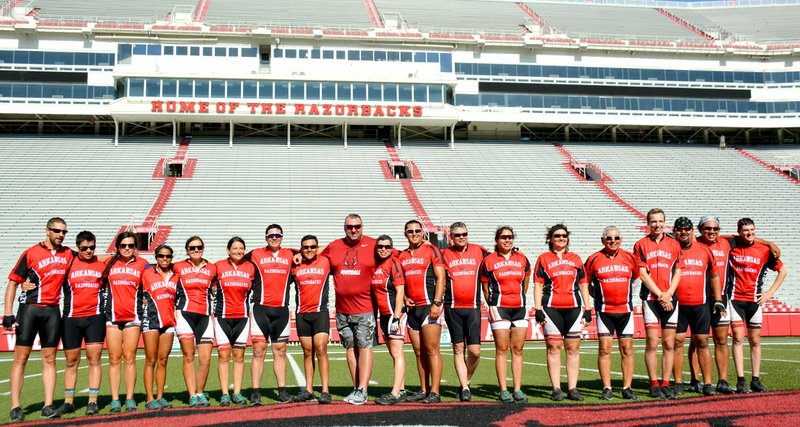Cherokee Nation's Remember the Removal Riders, including Glendon VanSandt of Siloam Springs, completed a 950-mile bicycle ride tracing the Trail of Tears on Thursday.
VanSandt was one of eight Cherokee Nation cyclists who have been training for the ride since February. They were joined by seven Riders from the Eastern Band of Cherokee and started their journey in New Echota, Ga., on June 5. The riders traveled through seven states to honor their ancestors who were forced to make the trek on foot more than 175 years ago, according to a press release from the Cherokee Nation.
In addition to the Remember the Removal Riders, Cherokee Nation citizens Stacy Leeds, Dean of Law at the University of Arkansas, rode as historian, Vietnam veteran Sammy Houseberg rode as an ambassador, and Kevin Jackson rode as a Cherokee Nation marshal and trainer.
During the last leg of their journey on Wednesday, the riders rode up the Razorback Greenway before making stops at the University of Arkansas School of Law, where they met with university chancellor Joseph Steinmetz, and at Razorback Stadium, where they met with head football coach Bret Bielema. They rode to the Prairie Grove Civil War Battlefield, where they ate lunch, then traveled down Arkansas Highway 62 into Oklahoma.
Their journey ended on Thursday when they rolled onto the lawn of the Cherokee Nation Courthouse, according to the press release. The riders were welcomed by Cherokee leaders, family members and friends, and received medals from Principal Chief Bill John Baker and Deputy Chief Joe Crittenden.
VanSandt said that completing the ride was bittersweet. The 16-year-old was proud to have completed the long ride and excited to be reunited with his family, yet sad that the journey was over and that he would be parting from his fellow riders.
The best part of the trip for VanSandt was the friends he made along the way and the bond he made with both the Cherokee Nation riders and the riders from the Eastern Band.
"A big (memory), is knowing that there are people in North Carolina that are basically family now," he said. "That's why it was so hard to say goodbye today because I don't know when I'll see them again."
The most difficult part of the journey for VanSandt was knowing that other people were suffering on the same path he was on.
"That was pretty hard," he said. "It stuck in my mind throughout the whole journey and helped me push through all the hard times I had."
The cyclists visited various gravesites and historic landmarks along the trail. Mantle Rock in Kentucky was the most meaningful to VanSandt. The weather was so cold when the Cherokee people were forced to be removed that the Ohio River froze over and the ferry that was supposed to carry them across the river couldn't operate.
The people took shelter underneath the the overhang of the rock, VanSandt said. They had the children crawl back as far as they could into the little space under the rock, then the parents lined up in front to shield them from the weather and keep them warm.
"That was really tough to think about," he said.
Other stops along the way included Blythe Ferry in Tennessee, which was the last piece of Cherokee homeland the ancestors stood on before beginning the trek to Indian Territory, and Shellsford Cemetery in Tennessee, where Cherokee who died on the route are buried in unmarked graves, the release stated.
"I definitely think that history is going to play a big role in my life," VanSandt said. "Now I'm curious and I want to know more. I've learned so much on this ride, whether it was about the Trail of Tears, or my ancestors or about life... I'm definitely going to pursue learning more about our heritage."
While VanSandt's trainers warned the riders about the steep inclines they would face in the Cumberland Gap, the most difficult part of the ride was the tough, up and down hills of southern Missouri, he said. VanSandt said the riders from both Cherokee groups bonded, and told jokes and stories to pass the time and get through the hills.
"It kept our minds off all the pain in our legs and the steepness of the hills," he said.
Many of the riders have used the experience to change the way they view daily life, VanSandt said. Completing a 950-mile bicycle ride has given them a whole new level of confidence and made other challenges in life seem less daunting in comparison, he said.
"It will be cool to see how this changes my life," VanSandt said.
For the first time since the Cherokee Nation started the ride in 1984, participants received three hours of college credit from Northeastern State University after the completion of the ride, the press release stated. The U.S. National Park Service awarded a $15,000 grant to the Remember the Removal Bike Ride for cyclists to promote the national parks along the trail, it stated.
"When I look out at these fine young adults today, I see true leadership," said Principal Chief Bill John Baker. "I see a bond that has formed that is like family, and I see Cherokee values like perseverance and fortitude. We are so proud of these young men and women. Over the past three weeks, they have been asked time and time again, 'Why are you doing this?' And the answer has always been the same, 'To remember our ancestors and what they accomplished to come to a new land and start over. We will never forget their sacrifices, and we are here today thriving, stronger than ever, because of our strength."
VanSandt plans to pass on his experience and newly gained knowledge about the Trail of Tears and Cherokee history.
"It's something that should be shared, not only with my kids, but with everyone," he said. "Everyone should get the chance to at least hear about it."
General News on 06/26/2016
